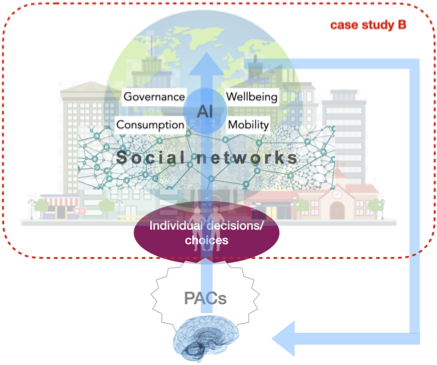|
The goal of this case study is to examine cities as social networks, how human-social choices define these networks and how digital tools applied at various levels shape urban interactions and change.
Digitalisation facilitates new analytic tools to interpret, model, and assess how humans interact and behave in urban environments. New Urban Science is set to provide insights on urban functions that can be used to inform solutions to real-world problems, in particular regarding design strategies for smart cities. Sustainable smart city design depends on the underlying dynamics of human choices related to consumption, well-being (incl lifestyle), mobility and governance (political and socio-economic organisations). The widely accepted societal agenda is sustainable development that both mitigates and adapts to climate and environmental change while maintaining citizens' well-being. In line with this agenda, we wish to better understand the role of human-social behaviour and choices in social networks facilitated by enhanced digitalisation, specifically in the context of evolving smart cities. The case study involves three steps:
|
|

|
1) Psychological basis for individual and collective decision-making
Given the significance of human values, preferences and ultimately
choices, for the design of smart cities, it is important to
understand the psychology of choice in the urban
context. Behavioural economics provides a broad framework for
quantifying choices between uncertain gains or losses, which is a
starting point. Sustainable smart cities are seRng a more complex
context that includes ethical, emotional and ultimately existential
issues in addition to material gains/losses. In this step, we will
develop a conceptual framework to define the most important
psychological factors of decision-making in a sustainable smart city
context, from individual to the collective. We will also examine how
digital tools can be used to extend and enhance specific
environmental, social, and economic agendas in urban systems viewed
as multi-level, integrated social networks.
2) Individual choices and social networks
A dynamic framework and parametrisation for economic choices as prospects and simple game strategies will be developed and verified based on broad literature data. This step will provide a novel basis for linking individual decision making at the mesoscale with decisions
in social networks at the macro-scale. In line with overall HiSS project goals, we shall attempt to also relate individual decision-making at the mesoscale to neuro-cognitive processes at the micro-scale. The focus of this step will be relatively small social networks, from single to multiple (two, three) agents. Canonical two-agent interactions are simple games with strategic binary choices. As a systematic approach, the most basic prototype simple strategic games will first be considered, from matching pennies to prisoners dilemma to evaluate and verify the conceptual framework; prisoners dilemma, for instance, has been shown to be highly relevant in many real-life contexts where the balance between competition and cooperation is at stake. Other games will be considered to explore for sustainability particularly relevant balance between exploration and exploitation. The overall goal of this step is to define a common dynamic framework between classical economic choices and strategic games that can be expanded to multiple interacting agents in networks. The methodology for this step will draw from behavioural economics, game theory, information theory, consensus in social networks, reinforcement learning, etc.
3) From social networks to collective action
In this step, four important application areas of human-social
interactions will be addressed (Figure). Human-social
choices/behaviour in real-world urban conditions are to be
considered from building-scale testbeds to districts or parts of
cities; our focus will be on the City of Stockholm. The first
application area is consump6on where the focus is on energy/
resource use in apartments and/or office buildings. The starting
point will be observations from the LiveIn-Lab (Case Study C),
specifically tenant choices/behaviour and possible effects of social
networks on this behaviour. The extension from the lab to real-world
conditions is planned at Hammarby sjöstad, in line with Case
Study A. The second application area is mobility with a relatively
wide literature that will be our starting point. Here we will
revisit existing mobility data or collaborate in acquiring new data,
for the specific purpose of deeper understanding human mobility
choices, from individual to multiple interconnected agents. The
third application area is governance where the focus will be on
social network interactions and effects in a typical voting
process. Finally, the fourth application area will be citizens
well-being with the purpose of better understanding the mechanisms
of social influence on individual lifestyle choices that are central
to well-being. Here we will try to take advantage of Case Study A
and connect with stakeholders in the Hammarby sjöstad district
to study if and how digital tools may enhance individual and
collective well-being as a central part of sustainable-smart city
agendas.
|
